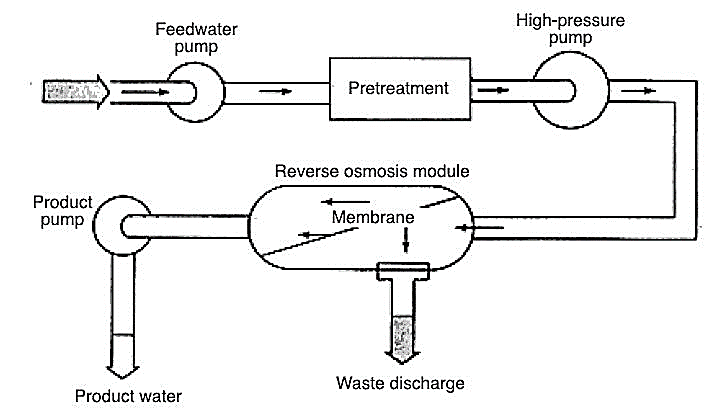
Seawater Desalination with Reverse Osmosis Plant
All Reverse Osmosis crops are fundamentally Desalination Plants but desalination is remaining referred to sea h2o normally.As sea h2o has incredibly large TDS involves very high pressure to pressure sea water through membranes that are distinct then brackish water membranes.
Reverse Osmosis Plant Facts:
A reverse osmosis plant is actually a producing plant, where by h2o is purified and desalinated by forcing drinking water by way of a membrane, usually often called a reverse osmosis system. Water produced by plant RO could possibly be utilized for several uses like desalination, wastewater remedy, as well as the reclamation of dissolved minerals.
RO Plant Description
A median ingesting h2o RO plant procedure necessitates six KW hrs of electricity to desalinate one cubic meter of h2o. Reverse osmosis drinking water vegetation requires a variety of pre-treatment approaches such as softening, DE chlorination, and anti-scale treatment method. Subsequent pre-remedy, substantial levels of strain send out drinking water through a semi-permeable membrane, which retains all contaminants except water.
RO Plant Style and design
To enhance the effectiveness and life of the Reverse Osmosis plant, successful pretreatment in the feed water is required. Number of the proper pretreatment will improve performance and membrane daily life by reducing:
Fouling
Scaling
Membrane Degradation
RO plant design is consisting of:
Identifying pretreatment need of Reverse Osmosis Plant
In the event the feed water has traces of large metals, it is highly suggested to dose some chlorine to change the dissolved hefty metals to Actual physical form, the media filter will filter a lot of it in a very ro drinking water purifier plant.
Reverse Osmosis Plant Variety of membrane
Membrane things are a crucial Component of RO crops. The proteins (mainly polyamide) that makeup membrane components differ depending upon the ending clarity and consumption drinking water seawater or brackish drinking water etcetera
Waterman engineers Australia RO plant for seawater desalination
Waterman Engineers in Australia has intended a Reverse Osmosis (RO) plant for seawater desalination, which delivers several advantages about other desalination techniques. Below are a few crucial great things about their RO plant:
Power Effectiveness:
Compared to other desalination approaches like thermal distillation, RO requires considerably less energy. Waterman Engineers' RO plant utilizes Innovative membrane technological innovation, allowing for it to work at reduce pressures and decrease General Vitality usage.
Environmental Influence:
RO generates considerably less brine discharge as compared to thermal procedures, lessening the effect on marine ecosystems. This aligns with Australia's give attention to environmental sustainability and conservation.
Substantial Water Purity:
The RO procedure successfully gets rid of salts, minerals, and impurities, producing large-high-quality freshwater that satisfies stringent ingesting water expectations. This dependability is crucial for supplying Secure and cleanse drinking water to communities.
Modular Style:
Waterman Engineers' RO plant employs a modular design and style, permitting for scalability and adaptability. This is particularly useful for places with different water calls for, as modules may be additional or modified accordingly.
Diminished Footprint:
RO crops normally Have a very smaller sized physical footprint in comparison to thermal desalination crops, which often demand comprehensive infrastructure for heating and cooling processes.
Rapid Start out-Up and Shutdown:
RO vegetation can be started Desalination Plant Manufacturer and stopped fairly quickly, allowing for better responsiveness to switching drinking water demands and emergencies.
Decreased Chemical Utilization:
Not like Various other desalination solutions, RO demands less chemical compounds for Procedure and cleaning, minimizing chemical-relevant environmental concerns.
Consistency in Performance:
The RO method is a lot less delicate to feedwater quality fluctuations than other strategies, guaranteeing a more reliable performance as time passes.
Expense-Usefulness:
When First investment decision prices may be considerable, RO crops have a tendency to possess decreased operational and upkeep prices Ultimately when compared to thermal techniques.
Reverse Osmosis (RO) can be a drinking water purification course of action that takes advantage of a partly permeable membrane to eliminate ions, unwelcome molecules, and larger particles from drinking drinking water. By implementing stress to beat osmotic pressure, it makes it possible for the passage of h2o molecules whilst rejecting contaminants, therefore generating thoroughly clean drinking water on 1 aspect of your membrane and concentrated impurities on the other.
The Doing work theory of the Reverse Osmosis (RO) plant will involve applying stress into a saline Option to drive h2o molecules through a semi-permeable membrane. This membrane enables only drinking water to move whilst rejecting salts, contaminants, and impurities, leading to purified drinking water on the permeate side along with a concentrated Remedy of contaminants about the brine aspect.
The benefits of Reverse Osmosis include creating large-high-quality, thoroughly clean water by getting rid of contaminants, getting effective and cost-efficient as time passes, demanding negligible chemical use, and staying adaptable to varied scales of operation from little home units to substantial municipal vegetation.
RO plants have changed Demineralisation (DM) vegetation since they often give a far more productive and value-powerful solution for h2o purification. RO techniques don't involve the regeneration chemical substances that resin-based DM vegetation do and can clear away a broader array of contaminants, including dissolved solids and microorganisms.
Waterman Engineers Australia probable makes use of Reverse Osmosis (RO) crops for seawater desalination by forcing seawater through a semi-permeable membrane to get rid of salt as well as other impurities. This method produces clean, potable h2o from your ocean, addressing drinking water scarcity and providing a sustainable provide for many wants.